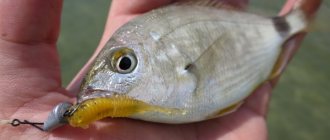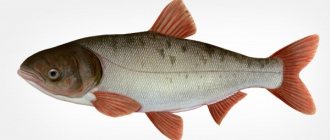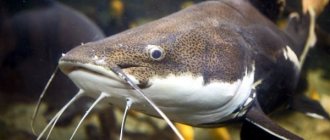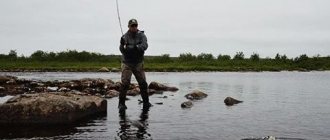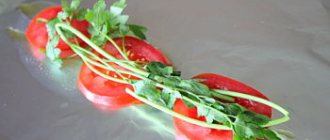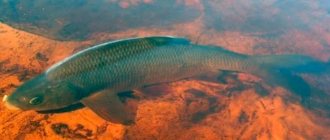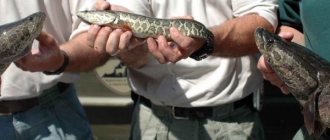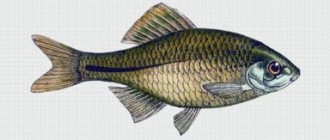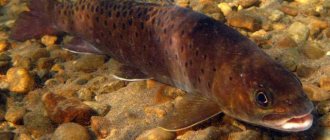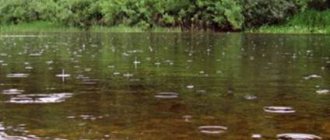Brown trout
or in other words,
kemzha
is a freshwater, migratory fish belonging to the Salmon family. There are many varieties of trout fish, which are very different from each other in both appearance and size. Brown trout is considered a large fish; its size can vary from 30 to 70 centimeters with a weight ranging from 1-5 kilograms. There are also particularly large fish that reach a length of 110 centimeters and weigh more than 20 kilograms.
Trout fish is an ecologically flexible species and due to this fact, its habitat is very large: the basin of the Barents Sea and the Pechora River; The Caspian, Aral, Baltic and Mediterranean seas and even the lakes of Dagestan. Roughly speaking, brown trout are trout that live in the ocean, not the river. There are known cases of brown trout fry turning into ordinary trout when the former are introduced into small rivers.
general information
Trout
Outwardly, different types of trout are very different from each other; they are confused not only by amateur fishermen, but also by specialists involved in the production of fish products. For example, brown trout are called trout, and this is true: some of its subspecies that live in streams and fresh lakes really belong to trout, but there are many species and subspecies of trout in the world.
There are several subspecies of trout, these are:
- Aral
- Caspian
- Black Sea
- pre-Caucasian
- Eisenam (living exclusively in Lake Eisenam between Dagestan and Chechnya).
All these salmon have a characteristic torpedo-shaped body with small scales, a head with a wide mouth and various spots on the body. Unlike salmon, there are spots below the lateral line. Red, black, orange, round or x-shaped, each type of brown trout has its own. Some may have no spots. Since this species is very variable, the “characteristic torpedo shape” is quite relative.
Appearance
The body is elongated, covered with dense scales. Dorsal fin III has 8-11 rays, anal fin II-III has 8-9. There are 13-18 gill rakers on the 1st arch, usually 14-16 (usually 18 in Baltic ones), the first and last ones are tuberculate. The upper jaw extends noticeably beyond the vertical of the posterior edge of the eye; the mouth is large and oblique. The minimum body height is usually no more than twice the length of the caudal peduncle. There are 10-12 gill rays. Pyloric appendages 40-66. The head of the opener is triangular in shape and has 3-4 teeth on the rear edge; On the body, its teeth are in 1-2 rows and are preserved longer than those of salmon. There is an adipose fin located between the dorsal and caudal fin. In mature males, the jaws bend, but much less than in salmon.
The body of adult fish is covered with numerous black spots and below the lateral line, there are round spots on the sides of the head and on the dorsal fin. In sexually mature individuals (especially males), numerous pink spots appear on the sides of the body. The young ones are colored like brook trout. In large lakes it has a predominant silver color. The length is usually 30-70 cm and weight 1-5 kg, but trout up to a meter or more, weighing 8-12 kg, are found in the Baltic Sea.
This species is very close to salmon, but differs from it in a number of features: smaller scales on the tail, fewer gill rakers, the shape of the first and last rakers (they are tuberculate), the shape of the head of the vomer and lingual bone, a longer maxillary bone, a shorter dorsal fin, a higher caudal peduncle, a less notched caudal fin (juveniles have a notch), a more pointed (adult) anal fin (when the anal fin is pressed to the body, its longest ray is grabbed posteriorly by the last ray, but in salmon it is not enough ). Finally, the coloration of brown trout is different. The geographical distribution also varies. Unlike adult salmon, adult brown trout also feed in the river.
Habitat
Trout fish
Anadromous and freshwater representatives usually live in the basins of large rivers with appropriate water. Caspian trout prefer the Caspian Sea, as its name suggests. Moreover, at the time when it goes to spawn, it can turn into freshwater. The mating season takes place on the Kura River. Another representative is salmon, which lives in the Azov and Black Seas. Thus, anglers have many places where they can catch such prey.
As indicated, all sea or lake fish belonging to this species have a distinctive feature. It lies in the fact that trout, in fact, does not care what kind of water it is: salty or fresh. She can live everywhere. This has a positive effect on its widespread distribution.
Trout (fish): description. Sea, lake and stream trout
Trout is a fish that belongs to the salmon family. Moreover, she is a typical representative of it. There are many subspecies of this fish, and each of them has its own distinctive characteristics. For example, some specimens do not exceed a weight of 2 kg, while others reach a weight of more than 20.
Brown trout has very tasty meat rich in useful elements. Therefore, many fishermen dream about it. In some places in Russia it is commercial. Minimal fat content, a normal amount of calories per 100 grams of weight, as well as excellent digestibility - all this represents the main advantages of fish.
Brown trout fish is quite common. Photos of fishermen with the corresponding trophy are found quite often, both in private collections and on various forums or thematic websites. Therefore, it is impossible to briefly talk about its habitat.
As indicated, all sea or lake fish belonging to this species have a distinctive feature. It lies in the fact that trout, in fact, does not care what kind of water it is: salty or fresh. She can live everywhere. This has a positive effect on its widespread distribution.
The appearance of members of the salmon family will vary depending on the subspecies. Most typical specimens, such as Taimyr, anadromous or freshwater trout, have the characteristics described below.
- Mouth slanted downwards.
- If the individual is large in size, then it has a characteristic hook on the lower jaw.
- Small fin on the back.
- Powerful tail.
- Small adipose fin.
- Spots all over the body.
The specimens also vary in weight. The largest fish is the Caspian trout. Photos on thematic websites introduce fishermen to specimens of 10 and 20 kg. In general, the mass of the expected prey can be determined from its habitat. If the reservoir is small, then the size and weight will be small, and vice versa.
Brown trout is a fish that, for spawning, selects areas of water bodies where it is shallow and there are a lot of stones. This is due to the fact that small eggs hide under them or bury themselves in the sand if it is large.
A distinctive feature of brown trout is that it continues to feed during spawning. Having released an average of 7-12 thousand eggs, the fish quietly engages in fishing for crayfish, herring, and so on.
Brown trout is a fish that can live 19-20 years. Anadromous and marine species have a shorter lifespan, unlike lake species. However, this time is enough for fishing; it is possible to enjoy adult meat without interfering with procreation.
It is believed that all fish of the salmon family (the list of representatives is very large) are predators by nature. Many people find small crayfish in their stomach while cutting. There are also other fish. In general, brown trout are not fixated on their diet; they are ready to eat everything that comes their way.
Brown trout spend most of their lives in salt water. It swims to freshwater rivers to spawn. The fry grows there too. As an adult, it returns to the sea or salt water lake.
As indicated, the largest representative is the Caspian trout. There is a recorded case in history when a fisherman managed to catch one weighing 51 kg. But today large specimens are not available, since fishing is observed wherever brown trout are found. Therefore, it simply does not have time to grow to such a large size.
Today, trout fishing is not as profitable as it was at the beginning of the 20th century. This is due to the fact that fishing is irrational, and in some of its habitats, hydraulic construction has begun. Therefore, the natural increase in population was disrupted. But the fish is not yet protected or protected by appropriate structures.
All fish of the salmon family (the list begins with ordinary trout and ends with Caspian trout) are caught by spinning or fly fishing if they spawn. Spawning takes place from September to February, depending on the climatic conditions of the habitat.
Lifestyle
Migratory and freshwater species. In the sea, brown trout settle and fatten near the shores and do not migrate long distances. It lives in the upper reaches of many rivers, but can sometimes be found in the middle reaches of rivers with rocky soil. This is a cold-loving fish that sticks to fast currents and needs a high oxygen content in the water. It can live for a long time in a section of the river chosen by it, in which shelters alternate with small places convenient for hunting. Hunting (morning and evening) is especially typical for large fish that inhabit rivers with very clean, clear water.
Small trout stay in Luga, Koporsk and Narva bays all year round. The entry of taimen into rivers by individual individuals begins in the spring and continues in the summer; a more intense course occurs in September, October and even November. The local trout stays in the river for 2-3 years before moving into the sea, and occasionally 4 years. It returns from the sea to the rivers after being in the sea for 1-2, less often 3 years.
Reproduction
During the summer and especially in the fall (August - September), brown trout enter the rivers, where in October - November they lay eggs in the sand and pebble soil. Fertility 4.7-8.3 thousand eggs. Spawns during life from 4 to 11 times. After spawning, it remains in the river for a long time and rolls into the sea only in the summer of next year, that is, after almost 10 months. Spawning in the river Luga - in the second half of November. From the sea, brown trout return to rivers to spawn after 2-3 years. In northern Sweden, brown trout swim to the sea, usually spending 3-4 winters in the river (sometimes up to 7 winters). Just like salmon, brown trout have spring and winter forms. In rivers, brown trout usually do not rise as high as autumn salmon, and willingly visit lakes.
The development of eggs continues throughout the winter. The larvae hatch in the spring. Young trout live in the river from one to five years, after which they slide into the sea, having a length of 10-20 cm. Young brown trout from the Kandalaksha Bay basin of the White Sea spend most of 4 years in the river. After living at sea from one to four winters, the White Sea trout returns to the rivers.
HelloSochi
2019 has been declared the International Year of the Salmon
The North Pacific Anadromous Fish Commission (NPAFC) and the North Atlantic Salmon Conservation Organization (NASCO) have designated 2021 as the International Year of the Salmon. And although the center of salmon species diversity is located in the east of our country, Sochi is of key importance for the conservation of a unique representative of this family - the Black Sea trout.
Black Sea trout is a relict and endemic species. For many thousands of years, this unique fish has lived in the Azov-Black Sea basin, having chosen its northeastern part.
Brown trout have two main forms – migratory and residential. The residential form is known as brook trout (Salmolabrax Pallas, 1814). Trout is a small predatory fish, a typical species for the upper reaches of small and large mountain rivers in the Sochi Black Sea region. It is capable of rising upstream in rapid mountain streams, overcoming even seven-meter waterfalls. Trout feeds mainly on small fish and invertebrate animals, including insects that fall into the water.
The migratory form of brown trout is often called Black Sea salmon (Salmotruttalabrax Pallas, 1814). Salmon is much larger than trout, capable of reaching meter sizes up to 24 kg in weight! Unlike trout, salmon migrate from streams to the sea. This fish begins its life cycle in the river where its parents were born. The hatched fry of the migratory trout descend into the sea already in the second year of life. This happens most often in the spring. Feeding mainly on fish, they fatten up to the age of four, reaching maturity.
Spawning for brown trout begins at the end of February and ends in June. Autumn spawning of brown trout takes place together with brook trout. During spawning, she rises into her native river to breed offspring. The ability of animals to return to their habitat is called homming in science. At the genetic level, the animal has a memory of its native watercourse. Brown trout lay their eggs in depressions dug at the bottom of the river in rocky soil. Cool, clean water washes and supplies the eggs with oxygen. After fertilization, the eggs are buried.
Surprising is the fact that after spawning the fish does not die, but returns back to the sea and is able to repeat the feat of motherhood up to 11 times in its life.
For most of the 20th century, Black Sea salmon had commercial significance, which has now been completely lost. Today, the anadromous form of the Black Sea trout is listed in the Red Books of Russia and the Krasnodar Territory with status 1 - an endangered species.
The main spawning rivers for brown trout in Russia remain only in the territory of Greater Sochi (Psou, Mzymta, Shakhe, Ashe, Psezuapse), although salmon have become very rare everywhere. In the Sochi rivers, salmon numbers were largely supported by the release of hatchery juveniles from trout farms in the region into the Mzymta and Shakhe rivers. These enterprises are engaged in breeding and growing, first of all, trout breeds bred as a result of selective breeding, as well as Black Sea salmon. Volume of salmon release in Mzymta and Shah in 2010–2015 amounted to 4.796 million copies. However, the numbers of this species continue to decline due to many objective reasons.
Human activity is often destructive to living organisms. The development of mountain river valleys, non-compliance with water protection standards during construction, pollution of watercourses and poaching lead to the destruction of natural diversity, including the disappearance of the endemic of our region - the Black Sea trout.
An environmental month is currently taking place in Sochi, timed to coincide with the International Environmental Action “March of Parks 2019”. Among its competitions, a competition of good deeds “Clean Rivers for Relict Brown Trout” has been announced. Anyone can take part in it by sending a report on the “good” event to the environmental education department of the Sochi National Park ( [email protected] ) by April 15.
We will be glad if as many residents and guests of the city of Sochi as possible join the environmental work, helping to preserve the natural wealth of the region.
Trout fishing
Fishing for trout
All fish of the salmon family (the list begins with ordinary trout and ends with Caspian trout) are caught using spinning or fly fishing if they are spawning. Spawning takes place from September to February, depending on the climatic conditions of the habitat.
The bite of brown trout is sharp, and you shouldn’t hook it right away. The fact is that it can easily break, as a result the fisherman will lose his trophy. First you need to tire her out a little. Then there will be no problems when pulling it ashore.
In general, fishing will be difficult regardless of whether you are catching sea or lake fish. Photos of people with corresponding trophies prove this. You can see very tired fishermen on them. Accordingly, you need to take a lot of nutritious food and fishing line with you, since the brown trout will not give up without a fight.
Recipes
Fish meat comes in both white and red. It all depends on the habitat and living conditions. Therefore, trout can be prepared in various ways. Let's look at the fastest and most popular ones.
Trout with broccoli
You will need:
- fish - depending on the number of people;
- 400 g broccoli;
- cheese;
- salt pepper.
Preparation:
Clean and divide the carcass into portions, pour lemon juice on both sides. Leave for half an hour, then bake at 140 degrees for 40 minutes. Simmer broccoli in water and olive oil for up to 7 minutes. Grate the cheese on a coarse grater. Cover the fish with broccoli and sprinkle with cheese, then place in the oven for 5 minutes.
Fish with vegetables
You will need:
- 2.5 kg sea trout;
- tomatoes – 1 kg;
- celery and leek - 3 stalks;
- butter, lemon juice and herbs - to taste.
Cooking method:
Divide the meat into portions, cut the vegetables into rings. Distribute the ingredients evenly on the baking sheet. Salt and pepper at the owner's discretion. Make a sauce from lemon juice and butter. Pour over the fish and place in the oven at 140 degrees for 40–60 minutes.
Recommended to be served with a side dish.
Trout with rice, raisins and potatoes
You will need:
- Half a kilo of potatoes;
- Raisins (1 spoon is enough);
- Salt and pepper - to taste;
- Rice – 200 g;
- Orange – 1 piece;
- Onions – 2 pcs;
- Trout fillet – 1 pc.
To learn more:
Chinook salmon: a unique fish of the salmon family
Cooking method:
Finely chop the potatoes and simmer until half cooked with a small amount of water. Rinse the rice in cold water and cook. Cut the orange into slices. Fry the trout fillet on each side for no more than 3 minutes. After cooking, remove the fillet to a warm place. Cut the onion into rings and fry in brown trout oil, add potatoes and orange peels. Add raisins to rice and mix thoroughly. After this, mix the ingredients in a plate in equal portions.
Brown trout meat
The salmon breed in question is in no way inferior to animal meat in terms of taste and culinary qualities. Moreover, when prepared correctly, it is even better. First of all, this lies in the fact that meat is easily digestible, even by small children.
Trout is not an oily fish, but very tender. This is due to the fact that there are layers of fat on the meat in its carcass. But they are located unevenly, so some parts of the animal can only be cooked in one way, while others offer room for culinary imagination. Also, the amount of fat depends on the time of fishing; during spawning, for example, the fish gets fatter, and by the end of it it becomes thinner.
Interesting facts about fish
As indicated, the largest representative is the Caspian trout. There is a recorded case in history when a fisherman managed to catch one weighing 51 kg. But today large specimens are not available, since fishing is observed wherever brown trout are found. Therefore, it simply does not have time to grow to such a large size.
In some cases, migratory, saltwater and lake fish may spawn together. This is observed where two corresponding bodies of water connected by one river are located in close proximity to each other. They go together and completely peacefully to the spawning process, and no one experiences any discomfort.
Today, trout fishing is not as profitable as it was at the beginning of the 20th century. This is due to the fact that fishing is irrational, and in some of its habitats, hydraulic construction has begun. Therefore, the natural increase in population was disrupted. But the fish is not yet protected or protected by appropriate structures.
